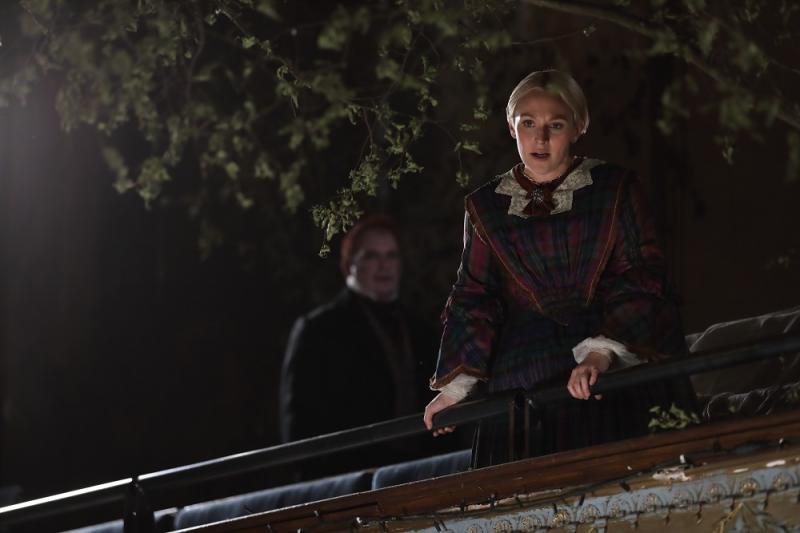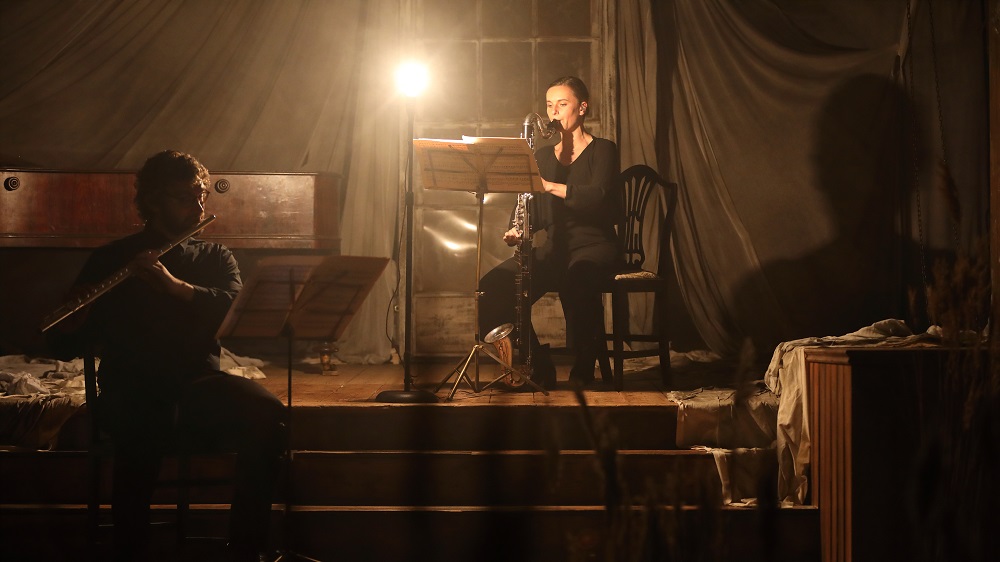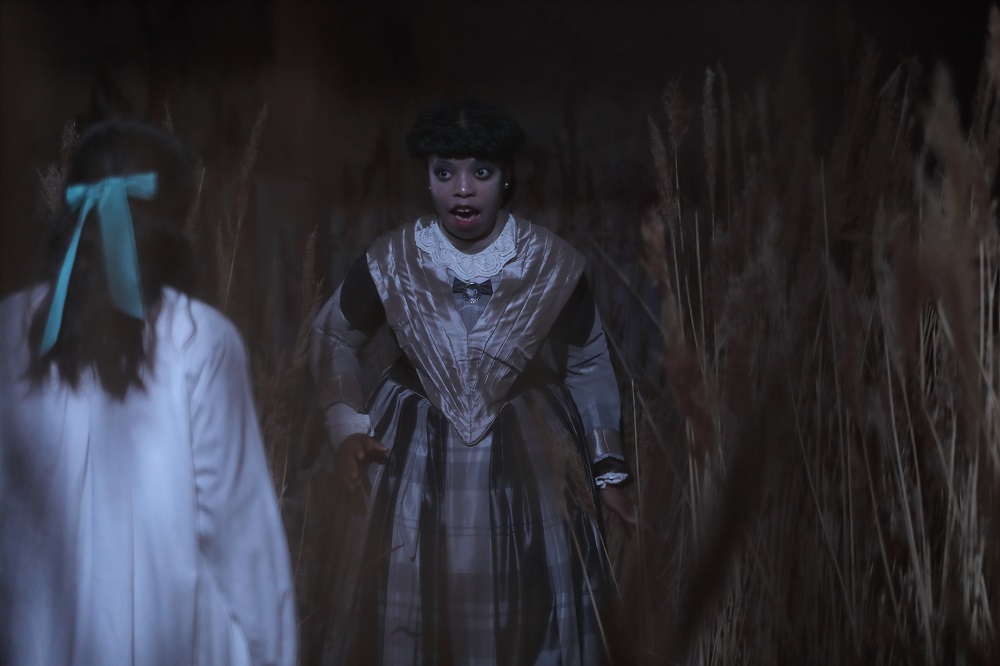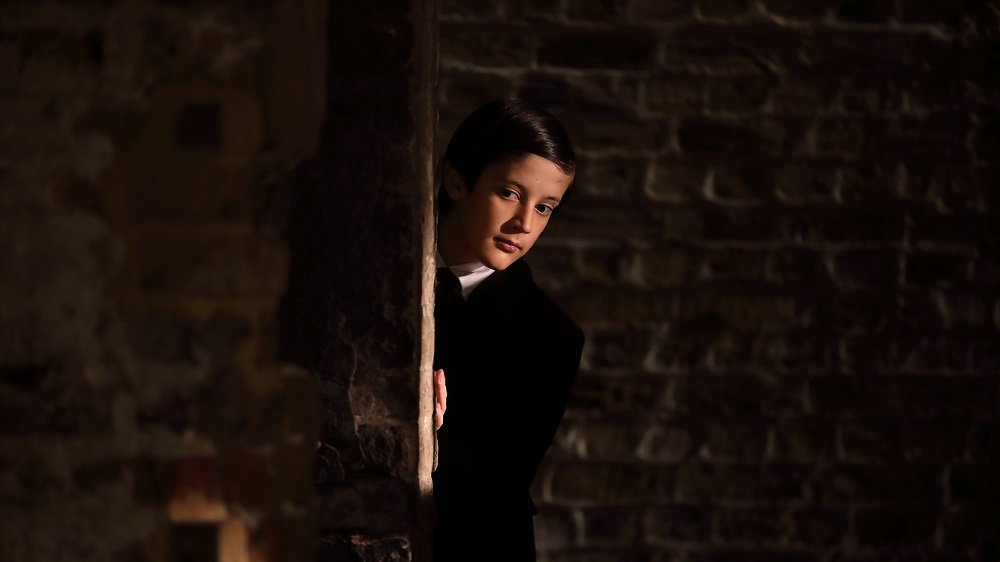The Turn of the Screw, OperaGlass Works online review - the fright is in the filming | reviews, news & interviews
The Turn of the Screw, OperaGlass Works online review - the fright is in the filming
The Turn of the Screw, OperaGlass Works online review - the fright is in the filming
Britten’s chamber opera chills in camerawork and high musical values

It’s second time lucky for OperaGlass Works, whose previous production at Wilton’s Music Hall, of Stravinsky’s The Rake's Progress, hit the mark for me in the singing but not the staging. I suspect that had we been there in the auditorium with performers all too palpable, the same might have been true of The Turn of the Screw in this venue.
The visual success, then, is almost entirely down to Dominic Best’s filming. The two levels here, parallel to those in James’s novella which come under threat in the opera when the ghosts speak, or sing, albeit in elusive language of enticement and corruption, are the “curious story” told by stage directors Selina Cadell and Eliza Thompson, too straightforward and under-nuanced until an ending that for me makes no sense, and the cameras exploring all areas of Wilton’s, focusing on cobwebby decay and dark corners, moving up and down sinister stairs.  It’s not only the grand piano on the stage proper which stays spookily unoccupied as Robert Murray’s Prologue narrator enters the building for his accompanied recitative (superbly articulate); the music stands remain without players sitting in front of them until little by little we see (uncredited) members of the Sinfonia of London: the four woodwind "birds" that frame the governess’s short-lived summer idyll in the grounds of Bly (reedbeds where the stalls would be), later two of them taking up the creepy alto flute and bass clarinet for the troubling bedroom scene in Act Two (pictured above), a lone cellist, a pair of violinists. These are ghosts more half-glimpsed than the characters of Quint and Miss Jessel, while Best makes a virtue of conductor John Wilson only ever seen on screen – the full instrumental ensemble was recorded in Cadogan Hall – later to be superseded by the male ghost.
It’s not only the grand piano on the stage proper which stays spookily unoccupied as Robert Murray’s Prologue narrator enters the building for his accompanied recitative (superbly articulate); the music stands remain without players sitting in front of them until little by little we see (uncredited) members of the Sinfonia of London: the four woodwind "birds" that frame the governess’s short-lived summer idyll in the grounds of Bly (reedbeds where the stalls would be), later two of them taking up the creepy alto flute and bass clarinet for the troubling bedroom scene in Act Two (pictured above), a lone cellist, a pair of violinists. These are ghosts more half-glimpsed than the characters of Quint and Miss Jessel, while Best makes a virtue of conductor John Wilson only ever seen on screen – the full instrumental ensemble was recorded in Cadogan Hall – later to be superseded by the male ghost.
I could have done without the alienation technique of occasionally letting us see the camera crew and sound technicians at work; even the fierce fugal interlude which prefaces the schoolroom scene needs to stay within the realms of the claustrophobic drama, and I’m not sure about the implied spooking of this production team in Act Two. But the interludes are mostly well handled – black slides across the screen at the end of each tableau, and the title of the next is cleverly projected in different parts of the set.  All six singers are first-rate. Rhian Lois’s Governess, with her pretty youthfulness and pristine light lyric soprano, looks at first as if butter wouldn’t melt; but fuller and more threatening stops are progressively pulled out, starting with her fierce brushing-aside of the girl Flora in favour of the boy Miles during the schoolroom lesson. If they only come in fits and starts during Act Two, that’s down to the one-dimensional stage direction. Cadell and Thompson never give us the possibility that the ghosts may be purely conjured up by the young woman. By then, at least, the camerawork keeps Murray’s red-haired horror and Francesca Chiejina’s wanly insistent Miss Jessel (pictured above with Alys Mererid Robers) more often at a distance; it’s a mistake, I think, to see their standard white-faced make-up earlier.
All six singers are first-rate. Rhian Lois’s Governess, with her pretty youthfulness and pristine light lyric soprano, looks at first as if butter wouldn’t melt; but fuller and more threatening stops are progressively pulled out, starting with her fierce brushing-aside of the girl Flora in favour of the boy Miles during the schoolroom lesson. If they only come in fits and starts during Act Two, that’s down to the one-dimensional stage direction. Cadell and Thompson never give us the possibility that the ghosts may be purely conjured up by the young woman. By then, at least, the camerawork keeps Murray’s red-haired horror and Francesca Chiejina’s wanly insistent Miss Jessel (pictured above with Alys Mererid Robers) more often at a distance; it’s a mistake, I think, to see their standard white-faced make-up earlier.
Gweneth Ann Rand‘s housekeeper isn’t allowed the nuance that can make her a more insidious participant, but then perhaps that isn’t in the libretto; her wide-eyed perplexity is alarming in itself and her narrative of Bly’s dark recent past duly chills. As usual, Flora is the older rather than the younger of the siblings, and allowed more rein to freak us out in Alys Mererid Roberts’ vivid characterisation than the less easy-to-read fixity of Leo Jemison’s Miles (pictured below). His direct-to-camera looks, though, are as impressive as Lois’s, and his treble has piercing sadness in it.  Full marks for an absence of dry ice; camera filters and angles work in conjunction with Tom Piper’s set and Lewis Hannaby’s lighting to make the turns of the screw increasingly queasy. And the playing under Wilson is absolutely brilliant, with special focus on Britten’s unique writing for harp. But then the composer gives each and every one of his instrumentalists the most extraordinary solos. All deserve to be named at the end (they're not, and I'm told the names can't be divulged, reason not given), not least because I suspect many viewers won’t have realised that all that sound and sometimes fury is conjured from a mere 13 players. Praise be to the funding of this project for giving them, and the singers, a rare chance to shine in the darkest of times.
Full marks for an absence of dry ice; camera filters and angles work in conjunction with Tom Piper’s set and Lewis Hannaby’s lighting to make the turns of the screw increasingly queasy. And the playing under Wilson is absolutely brilliant, with special focus on Britten’s unique writing for harp. But then the composer gives each and every one of his instrumentalists the most extraordinary solos. All deserve to be named at the end (they're not, and I'm told the names can't be divulged, reason not given), not least because I suspect many viewers won’t have realised that all that sound and sometimes fury is conjured from a mere 13 players. Praise be to the funding of this project for giving them, and the singers, a rare chance to shine in the darkest of times.
The future of Arts Journalism
You can stop theartsdesk.com closing!
We urgently need financing to survive. Our fundraising drive has thus far raised £49,000 but we need to reach £100,000 or we will be forced to close. Please contribute here: https://gofund.me/c3f6033d
And if you can forward this information to anyone who might assist, we’d be grateful.

Subscribe to theartsdesk.com
Thank you for continuing to read our work on theartsdesk.com. For unlimited access to every article in its entirety, including our archive of more than 15,000 pieces, we're asking for £5 per month or £40 per year. We feel it's a very good deal, and hope you do too.
To take a subscription now simply click here.
And if you're looking for that extra gift for a friend or family member, why not treat them to a theartsdesk.com gift subscription?
more Opera
 La bohème, Opera North review - still young at 32
Love and separation, ecstasy and heartbreak, in masterfully updated Puccini
La bohème, Opera North review - still young at 32
Love and separation, ecstasy and heartbreak, in masterfully updated Puccini
 Albert Herring, English National Opera review - a great comedy with depths fully realised
Britten’s delight was never made for the Coliseum, but it works on its first outing there
Albert Herring, English National Opera review - a great comedy with depths fully realised
Britten’s delight was never made for the Coliseum, but it works on its first outing there
 Carmen, English National Opera review - not quite dangerous
Hopes for Niamh O’Sullivan only partly fulfilled, though much good singing throughout
Carmen, English National Opera review - not quite dangerous
Hopes for Niamh O’Sullivan only partly fulfilled, though much good singing throughout
 Giustino, Linbury Theatre review - a stylish account of a slight opera
Gods, mortals and monsters do battle in Handel's charming drama
Giustino, Linbury Theatre review - a stylish account of a slight opera
Gods, mortals and monsters do battle in Handel's charming drama
 Susanna, Opera North review - hybrid staging of a Handel oratorio
Dance and signing complement outstanding singing in a story of virtue rewarded
Susanna, Opera North review - hybrid staging of a Handel oratorio
Dance and signing complement outstanding singing in a story of virtue rewarded
 Ariodante, Opéra Garnier, Paris review - a blast of Baroque beauty
A near-perfect night at the opera
Ariodante, Opéra Garnier, Paris review - a blast of Baroque beauty
A near-perfect night at the opera
 Cinderella/La Cenerentola, English National Opera review - the truth behind the tinsel
Appealing performances cut through hyperactive stagecraft
Cinderella/La Cenerentola, English National Opera review - the truth behind the tinsel
Appealing performances cut through hyperactive stagecraft
 Tosca, Royal Opera review - Ailyn Pérez steps in as the most vivid of divas
Jakub Hrůša’s multicoloured Puccini last night found a soprano to match
Tosca, Royal Opera review - Ailyn Pérez steps in as the most vivid of divas
Jakub Hrůša’s multicoloured Puccini last night found a soprano to match
 Tosca, Welsh National Opera review - a great company reduced to brilliance
The old warhorse made special by the basics
Tosca, Welsh National Opera review - a great company reduced to brilliance
The old warhorse made special by the basics
 BBC Proms: The Marriage of Figaro, Glyndebourne Festival review - merriment and menace
Strong Proms transfer for a robust and affecting show
BBC Proms: The Marriage of Figaro, Glyndebourne Festival review - merriment and menace
Strong Proms transfer for a robust and affecting show
 BBC Proms: Suor Angelica, LSO, Pappano review - earthly passion, heavenly grief
A Sister to remember blesses Puccini's convent tragedy
BBC Proms: Suor Angelica, LSO, Pappano review - earthly passion, heavenly grief
A Sister to remember blesses Puccini's convent tragedy
 Orpheus and Eurydice, Opera Queensland/SCO, Edinburgh International Festival 2025 review - dazzling, but distracting
Eye-popping acrobatics don’t always assist in Gluck’s quest for operatic truth
Orpheus and Eurydice, Opera Queensland/SCO, Edinburgh International Festival 2025 review - dazzling, but distracting
Eye-popping acrobatics don’t always assist in Gluck’s quest for operatic truth

Add comment